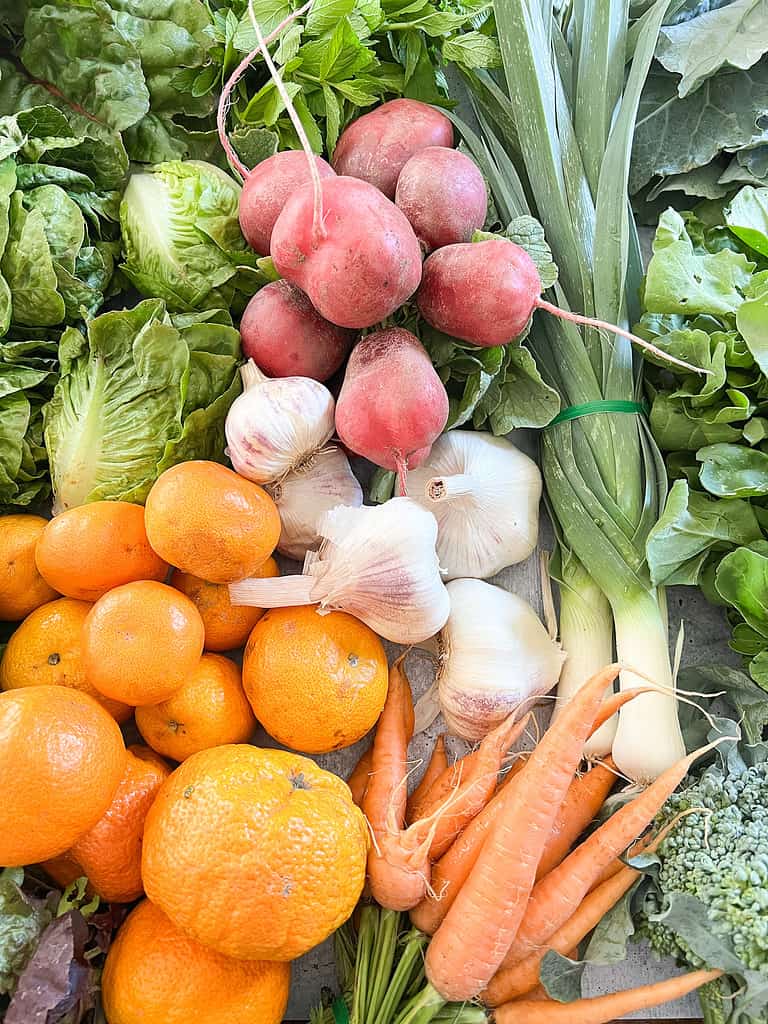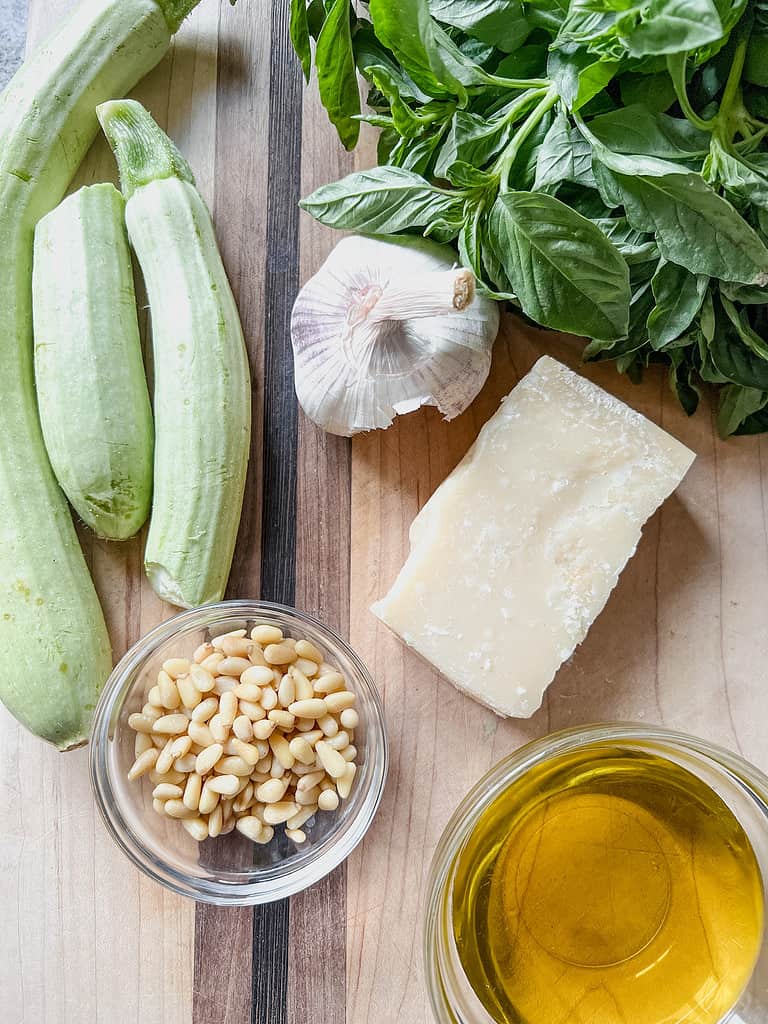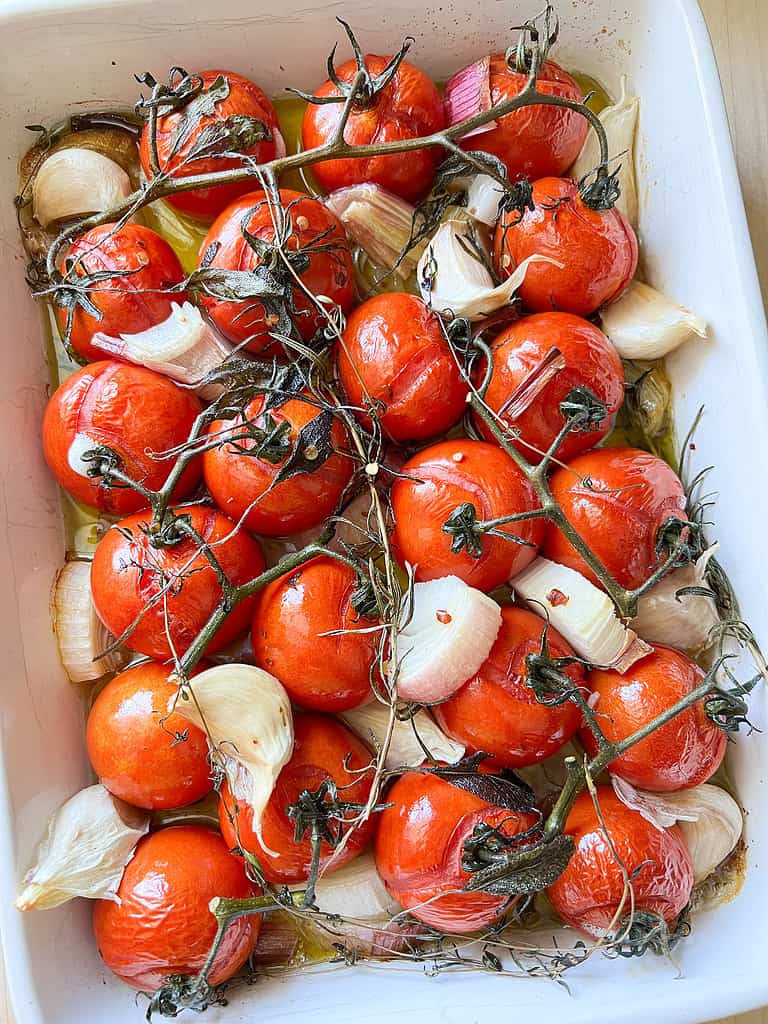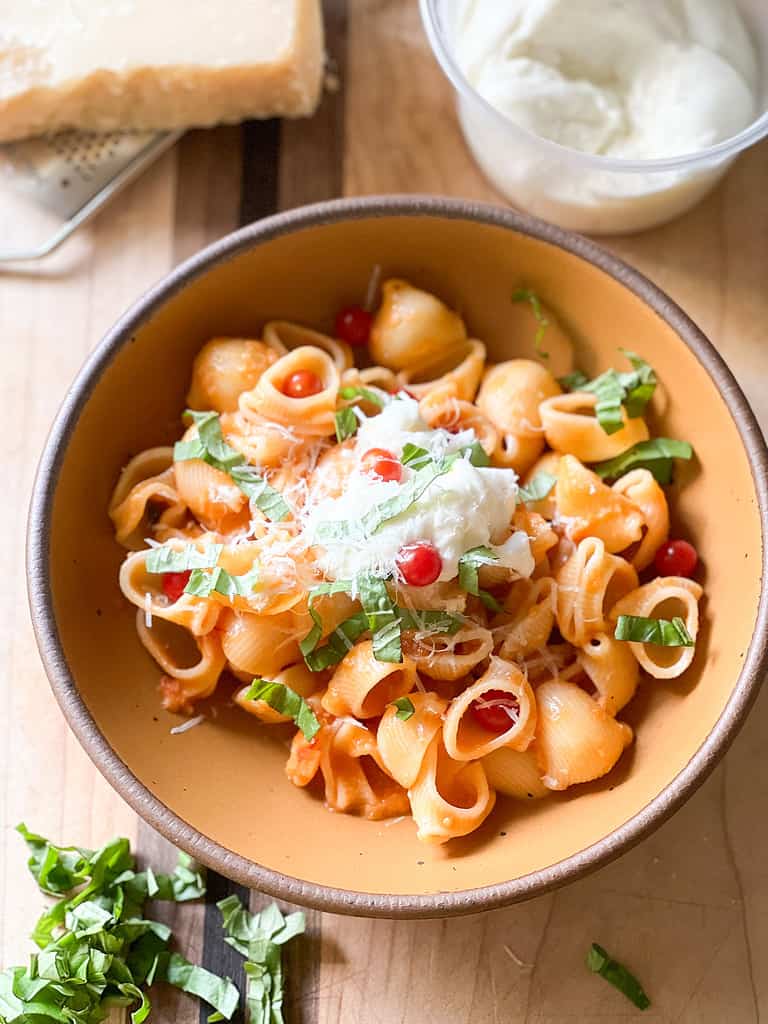When it comes to cooking with the seasons, it’s a treat when we get to learn about the different types of produce like garlic and note the differences between varieties like purple garlic vs white garlic. Garlic, a humble ingredient found in nearly every cuisine worldwide, is much more diverse than we may realize. While white garlic may be the most familiar variety to many, a variety that I’ve come to love lately is its cousin, purple garlic.
The fascination with the larger cloves and purple color in this variety of garlic came about after receiving a few heads in our CSA box from Sage Mountain Farm. Immediately I noted that this fresh garlic had a milder taste and milder odor than white garlic bulbs.
Today, we’re diving into the key differences between purple garlic and white garlic. We look at their unique characteristics and flavors and learn the ways we can use both in our everyday cooking.

What is Garlic?
Garlic, or allium sativum, is a bulbous flowering stalk like plant that is closely related to onions, leeks, shallots, and chives. Garlic is native to Central Asia and has been used as part of cooking and seasoning for centuries. The white cloves possess a variety of health benefits and have been widely used for medicinal applications.
How Purple Garlic Differs from White Garlic in Appearance
At first glance, the differences in appearance are clear: purple garlic has these beautiful purple stripes along the outer skins or papery sheath of the garlic head. This garlic is typically from the Italian purple garlic of the purple garlic varieties though there are others. This speaks to the major differences between the two garlic varieties about the type of crop:
White Garlic: Also known as “softneck” garlic, this is the most common type of garlic and can be referred to as the “regular garlic” that is seen in grocery stores. It features white bulbs with papery white skin and is typically available year-round. White garlic has a rich history, dating back thousands of years, and is believed to have originated in Central Asia. It has been cultivated in various regions worldwide and is known for its milder flavor and versatility.
Purple Garlic: Purple garlic is named for its stunning purple-striped outer skin. One popular purple garlic variety is Italian Purple Garlic. It comes from the hardneck varieties where a hard woody stalk grows through the center of the bulb. Thus, a hard-neck garlic bulb forms as a result. This hardneck garlic boasts a vibrant and visually appealing appearance given the vibrant purple skin surrounding the large cloves. Purple garlic is known for its robust, slightly peppery flavor and is often favored by garlic enthusiasts for its unique taste. Other purple garlic types include Killarney Red which we are growing in our garden now.

Flavor Profile Differences in Purple Garlic vs White Garlic
When conducting an at-home taste test, little the differences in taste between white garlic cloves and purple garlic cloves were marginal. Though a couple of key notes can be made:
White Garlic: White garlic has a slightly milder and more neutral flavor compared to its purple counterpart. Its taste is also often described as sweet and slightly nutty. This makes it an incredibly versatile ingredient for a number of dishes. White garlic works well in recipes where you want a subtle garlic flavor that doesn’t overpower other ingredients. I also love using it to flavor homemade broths and stocks for soups and stews.
Purple Garlic: Purple garlic, on the other hand, has a bit more zing though still a milder taste. It is definitely a little more fragrant but in a delicious way. It offers a more complex garlic flavor with hints of heat and a peppery bite. This variety is perfect for dishes where you want the garlic to take center stage, enhancing the overall taste of your culinary creations. I love making a compound butter from roasted purple stripe garlic cloves or grating raw garlic into a vinaigrette.

How to Cook with These Varieties of Garlic
Cooking with either garlic type demonstrates its own versatility. You cannot go wrong with either in terms of taste. When cooking with garlic, you can peel cloves at a time or roast the entire bulb. I love roasting whole bulbs of garlic in a bit of olive oil to make a compound butter. Alternatively, you can take the peeled cloves of garlic and roast them in a bit of olive oil on low heat to create a confit. This affords a unique flavor when spread on toasted slices of bread. A few ideas to kick off cooking with garlic to add stronger flavor to a number of dishes:
- Mince bigger cloves of garlic to use in a number of pasta sauces, soups, and sautéed vegetables.
- Slice softneck types of whole cloves in half for recipes where garlic compliments other ingredients without dominating the taste.
- Grate raw cloves of garlic to use in a compound garlic butter and or roast whole cloves to make a savory butter. This offers a subtle garlic aroma and flavor.
- Add cloves of purple garlic in dishes that call for a more pronounced garlic flavor, such as garlic-heavy sauces, marinades, and aiolis.
- Fry or crisp up thin slices of garlic cloves to make a crispy garnish to soups and salads to add a bit of crunch to the dish.
- Purple garlic is also an excellent addition when used for making garlic-infused oils and vinegars, enhancing the overall aroma and taste. You can still do the same with white varieties of garlic.
- Don’t forget the scapes! The garlic scape is also a delicious part to enjoy during summer. Sauté the scapes in olive oil or use in pestos. I also loved topping our weekly pizzas with these.

Harvesting and Storing Garlic
Generally, garlic is ready to harvest anywhere from 8 to 9 months after planting. Here are the quick facts about when garlic is harvested:
White Garlic:
- White garlic is typically harvested in early summer.
- It has a longer shelf life and can be stored for up to 8-12 months when kept in a cool, dark place with good ventilation.
Purple Garlic:
- Purple garlic is usually harvested a bit earlier than white garlic, in late spring.
- It has a shorter shelf life, typically lasting 4-6 months, so it’s best to use it relatively quickly or preserve it by pickling or making garlic paste. When stored too long the garlic cloves may shrivel or begin to sprout. Neither is bad but both are an indication that the garlic is no longer at its peak quality
When it comes to storing garlic, I’ll sometimes grate cloves of garlic and store them in a bit of water in small ice cube trays in teaspoon amounts. Then I can freeze it! When I need to use garlic for a recipe and fresh cloves are not available, I’ll pop in a freezer cube of garlic and it works like a charm.

Year-Round Recipes for Garlic
Both white garlic and purple garlic have their unique characteristics and flavors, making them valuable additions to your kitchen. The choice between the two depends on the specific dish you’re preparing and your flavor preferences. White garlic offers a mild, versatile option, while purple garlic packs a bold, spicy punch. A few recipes I love to make when I have lots of garlic on hand include:
- Easy Ratatouille with Herbed Polenta
- Maple Harissa Roast Carrot Soup with Crispy Garlicky Mushrooms
- Robust Heirloom Tomato Sauce for Pasta
Whichever variety you choose, experimenting with different types of garlic will undoubtedly elevate your culinary creations, adding depth and complexity to your dishes. So, next time you’re at the market or the farmers’ markets, don’t be afraid to try some purple garlic and explore the world of garlic beyond the white bulb you’re familiar with. Happy cooking!


Leave a Reply